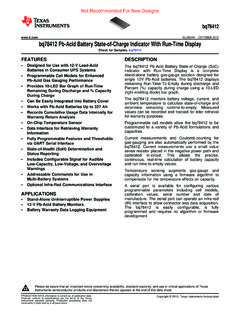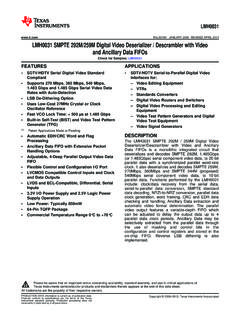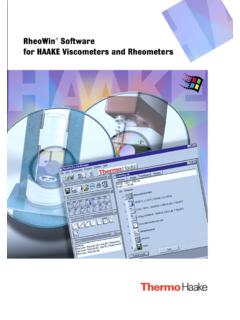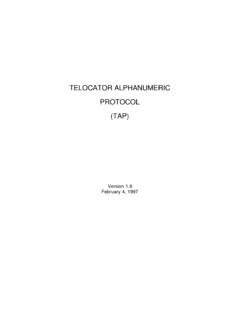Transcription of Determination of Bit Timing Parameters for the …
1 APPLICATION NOTE. Determination of Bit Timing Parameters for the CAN Controller SJA 1000. AN97046. Philips Semiconductors Determination of Bit Timing Parameters for the Application Note CAN Controller SJA 1000 AN97046. Abstract The CAN protocol provides for programming of the bit rate, and the number and location of data samples in a bit period. Optimization of these Parameters guarantees message synchronization and proper error detection at the extremes of oscillator tolerance and propagation delay. A step by step method for calculating optimum CAN bit Timing Parameters for a given set of system constraints is presented. Support is given for adjustment of the CAN. controllers SJA 1000 and PCx82C200 from Philips Semiconductors. Detailed examples are included as well.
2 Philips Electronics 1997. All rights are reserved. Reproduction in whole or in part is prohibited without the prior written consent of the copy- right owner. The information presented in this document does not form part of any quotation or contract, is believed to be accurate and reliable and may be changed without notice. No liability will be accepted by the publisher for any consequence of its use. Publication thereof does not convey nor imply any license under patent- or other indus- trial or intellectual property rights. 2. Philips Semiconductors Determination of Bit Timing Parameters for Application Note SJA 1000 CAN Controller AN97046. APPLICATION NOTE. Determination of Bit Timing Parameters for SJA 1000 CAN Controller AN97046. Author(s): Egon J hnk, Klaus Dietmayer Systems Laboratory Hamburg, Germany Keywords CAN, Bit Timing , Bit Rate, Propagation Delay, Oscillator Frequency, SJA 1000, PCx82C200.
3 Date: 15th July 1997. 3. Philips Semiconductors Determination of Bit Timing Parameters for Application Note SJA 1000 CAN Controller AN97046. Summary The Controller Area Network (CAN) is a serial, asynchronous, multi-master communication protocol for connect- ing electronic control modules, sensors and actuators in automotive and industrial applications. A feature of the CAN protocol is that the bit rate, bit sample point and number of samples in a bit period are user programmable. This gives the user the freedom to optimize the performance of the network for his given application. During this optimization process the user has to be aware of the relationship between the bit Timing Parameters , the refer- ence oscillator tolerance and the various signal propagation delays in the system.
4 This report focuses on the Determination of bit Timing Parameters for the Philips CAN controllers SJA 1000 and PCx82C200. The basic CAN bit Timing relationships are explained, calculation rules are discussed and examples are given with respect to different system requirements. In addition to the sets of equations, graphs and tables are provided allowing an easy graphical Determination of bit Timing Parameters . 4. Philips Semiconductors Determination of Bit Timing Parameters for Application Note SJA 1000 CAN Controller AN97046. CONTENTS. 1. INTRODUCTION .. 7. 2. OVERVIEW ON CAN BIT Timing RELATIONSHIPS .. 7. Definitions .. 7. Structure of a Bit Period.. 7. CAN Bit Timing Control Registers.. 9. Oscillator Tolerance .. 10. Propagation Delay .. 10. Synchronization.
5 12. 3. DEFINITION OF BIT Timing REQUIREMENTS .. 12. Calculation Rules .. 13. Graphic Representations of the Calculation Rules .. 14. Definitions and Restrictions .. 15. Determination of the Maximum Bit Rate .. 15. Determination of a Proper Sample Point .. 16. 4. CALCULATION OF BIT Timing Parameters .. 17. Example Definition .. 17. Selecting Bit Timing Parameters Using the Graphic Representation.. 18. Example 1 .. 19. Step-By-Step Calculation of Bit Timing Parameters .. 21. Example 2 .. 22. Example 3 .. 23. 5. REFERENCES .. 25. APPENDIX .. 26. 5. Philips Semiconductors Determination of Bit Timing Parameters for Application Note SJA 1000 CAN Controller AN97046. (this page has intentionally been left blank). 6. Philips Semiconductors Determination of Bit Timing Parameters for Application Note SJA 1000 CAN Controller AN97046.
6 1. INTRODUCTION. The Controller Area Network (CAN) - [1] - is a serial, asynchronous, multi-master communication protocol for connecting electronic control modules, sensors and actuators in automobiles or industrial applications. A feature of the CAN protocol is that the bit rate, the bit sample point and number of samples taken in a bit period are user programmable. This gives the user the freedom to optimize the performance of the network for his given applica- tion. During this optimization process the user has to be aware of the relationship between the bit Timing parame- ters, the reference oscillator tolerance and the various signal propagation delays in the system. For example, choosing a later sample point in the bit period results in more tolerance with respect to propagation delay and therefore greater bus length.
7 Conversely, choosing a sample point closer to the midpoint of the bit period will allow a greater oscillator tolerance for each node in the system. It quickly becomes apparent that a large allowa- ble oscillator tolerance and a long bus length are conflicting goals, which can only be met through optimization of the bit Timing Parameters . This report is intended to support users of the Philips CAN controllers - SJA 1000, PCx82C200 - during this optimization process. The methods discussed in this report allow a CAN user to determine if the CAN bit Timing requirements can be met by the system the optimum bit Timing Parameters for a given set of system requirements. 2. OVERVIEW ON CAN BIT Timing RELATIONSHIPS. Definitions Structure of a Bit Period The definitions of the CAN bit Timing Parameters used in this report are closely related to those used to program the Philips CAN controllers (see [2], [3] and [4] for further information).
8 These relationships are shown in Fig. 1. The bit rate - fB i t - of a system characterizes the amount of data bits transmitted per time unit. It is defined as given by Equation (1): 1. f Bit = ------- (1). t Bit in 3-Sample Mode only Sample tSYNC_SEG tTSEG1 Point(s) tTSEG2. NBT, tBit Fig. 1 CAN Bit Time Segments 7. Philips Semiconductors Determination of Bit Timing Parameters for Application Note SJA 1000 CAN Controller AN97046. The Nominal Bit Time consists of the three non-overlapping segments SYNC_SEG, TSEG1 and TSEG2 with the corresponding time durations tS Y N C _ S E G , tT S E G 1 and tT S E G 2 . Mathematically, the time duration of the Nominal Bit Time, tB i t , is simply the sum of the segment durations: t Bit = t SYNC_SEG + t TSEG1 + t TSEG2 (2).
9 Each of these segments is specified as an integer number of the basic unit of time in a bit period, the so called Time Quantum (TQ). The time duration of a Time Quantum is one period of the CAN system clock, tS C L , which is derived from the oscillator reference, t C L K , (see Fig. 2). The CAN system clock can be adjusted by the user via a programmable prescaler (Baud Rate Prescaler, BRP) as given by Equation (3): 2 BRP. t SCL = BRP 2 t CLK = ---------------- (3). f CLK. t CLK. oscillator Baud Rate Prescaler (BRP). (user definable). CAN. system clock t SCL t t Bit CAN TSEG1 TSEG2. bit period (user definable) (user definable). SYNC_SEG. (fixed) sample point(s). Note: tSC L is the time duration of one Time Quantum (TQ). Fig. 2 Principle of deriving the bit period as implemented in Philips CAN controllers Another time segment of importance to CAN bit Timing calculations is the Synchronization Jump Width (SJW), with time duration tS J W.
10 The SJW segment is not a segment of the bit period but rather defines the maximum number of TQ by which a bit period can be lengthened or shortened in the event of resynchronization. Moreover, the CAN protocol allows the user to specify the bit sample mode (SAM) as either single sample or three sample mode (2 out of 3 voting). In single sample mode, the sample is taken at the end of the TSEG1 inter- val. In three sample mode, two additional samples are taken, spaced one TQ apart and just prior to the end of the TSEG1 interval, as shown in Fig. 1 and Fig. 2. The bit Timing calculations in this report are expressed in terms of the bit time segments, normalized to the period of the CAN system clock (SYNC_SEG, TSEG1, TSEG2, SJW and NBT), which makes the calculations inde- pendent of a specific bit rate.






